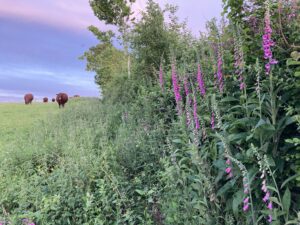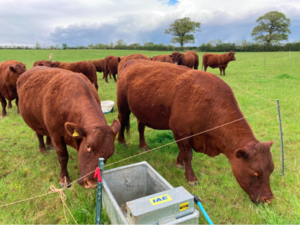Pasture Champions: Bella Lowes, Mill Barton Farm Mid Devon 2/4
 'We are keen to encourage the encroachment of the hedges into the fields'.
'We are keen to encourage the encroachment of the hedges into the fields'.
In the past couple of years we have dug multiple ponds and shallow scrapes, not only to provide water for our livestock where there are no permanent toughs but also to encourage more aquatic life - certainly dragon flies are an essential predator during fly season. The invertebrate hatches also provide food for swallows, house martins and swifts and in turn, they predate the flies which can become a nuisance to our livestock.
Having an option when it comes to water provision for the cattle means their impact doesn’t become an issue to the land - e.g. compaction or poaching. The ponds on the farm also catch a lot of the nutrient leaching before it gets into the watercourse - at the moment, the most recently dug ponds suffer from eutrophication fairly quickly demonstrating the unnaturally high phosphate in the soil.
Due to historic land management practices here, the clay is severely compacted in places and has suffered from significant topsoil depletion. However, it is recovering: we see not only in soil analyses but also with changes in the diversity of the sward - increasing pioneers, the amount of water we are able to store in the landscape, the flocculation of the soil and with all the animals who have come to take advantage.
In areas which are a few years into their restorative process, we see classic meadow species such as birdsfoot trefoil, lesser trefoil, ox-eye daisies, yellow rattle and red clover, as well as more Culm-specialty species such as common valerian, angelica, hemlock water dropwort, ragged robin and devil’s bit scabious. There is a lot of willow (goat and white), alder and hazel as well as more established oak and beech.
The bird life at Mill Barton is spectacular - we are regularly able to watch goshawks hunting, as well as the occasional passing hobby, peregrine and red kite. The warbler numbers, particularly garden warblers and blackcaps, are increasing in lockstep with increasing scrub cover in the goyles. We regularly see roe deer and foxes and more sporadically red deer and hares.
What you do to encourage this biodiversity and the lessons you have learned/would like to share?
All through the spring and summer, the cattle are mob-grazed around the farm: we use single strand polywire to place them where we need them. We don’t write a grazing plan because we have learnt that we stray from this almost straight away!
 Mob grazing
Mob grazing
We do aim to leave land for at least 50 days between repeat grazings. Instead of writing a plan, we respond to what we see in front of us: early in the year we need to keep them away from some of the wetter flushes, and later in the year we want to get the sward down really tight to allow us to hand-seed the ground behind them. We follow the cattle with horses - they cross graze extremely effectively and as a result, our parasitic worm burden is practically zero. We never worm any of our animals unless there is a clear issue, at which point we assess before administration. The horses also help in creating areas with an extremely short sward - suitable for oversowing and allowing seed fall - as well as leaving areas such as their latrines, which get much rougher. This is essential winter habitat and a good spring cache for the cattle.
Continue to read more of Bella Lowes and Mill Barton Farm...



